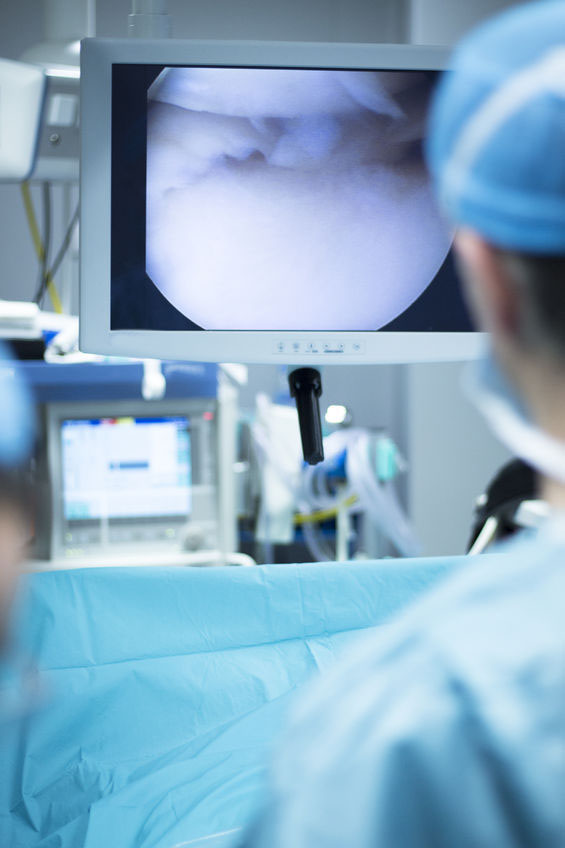

Arthroscopic surgery is used to identify, monitor, and diagnose joint injuries and disease; or to remove bone or cartilage or repair tendons or ligaments.
In arthroscopic surgery, an orthopedic surgeon uses an arthroscope, a fiber-optic instrument, to see the inside of a joint. After making an incision about the size of a buttonhole in the patient's skin, a sterile sodium chloride solution is injected to distend the joint. The arthroscope, an instrument the size of a pencil, is then inserted into the joint. The arthroscope has a lens and a lighting system through which the structures inside the joint are transmitted to a miniature television camera attached to the end of the arthroscope. The surgeon uses irrigation and suction to remove blood and debris from the joint before examining it. Other incisions may be made in order to see other parts of the joint or to insert additional instruments. Looking at the interior of the joint on the television screen, the surgeon can then determine the amount or type of injury and, if necessary, take a biopsy specimen or repair or correct the problem. Arthroscopic surgery can be used to remove floating bits of cartilage and treat minor tears and other disorders. When the procedure is finished, the arthroscope is removed and the joint is irrigated. The site of the incision is bandaged.

Arthroscopic surgery is used to diagnose and treat joint problems, most commonly in the knee, but also in the shoulder, elbow, ankle, wrist, and hip. Some of the most common joint problems seen with an arthroscope are:
Corrective arthroscopic surgery is performed with instruments that are inserted through additional incisions. Arthritis can sometimes be treated with arthroscopic surgery. Some problems are treated with a combination of arthroscopic and standard surgery.
Also called arthroscopy, the procedure is performed in a hospital or outpatient surgical facility. The type of anesthesia (local, spinal, or general) and the length of the procedure depends on the joint operated on and the complexity of the suspected problem. Arthroscopic surgery rarely takes more than an hour. Most patients who have arthroscopic surgery are released that same day; some patients stay in the hospital overnight.
Considered the most important orthopedic development in the 20th century, arthroscopic surgery is widely used. The use of arthroscopic surgery on famous athletes has been well publicized. It is estimated that 80% of orthopedic surgeons practice arthroscopic surgery. Arthroscopic surgery was initially a diagnostic tool used prior to open surgery, but as better instruments and techniques were developed, it began to be used to actually treat a variety of joint problems. New techniques currently under development are likely to lead to other joints being treated with arthroscopic surgery in the future.
Before the procedure, blood and urine studies and x rays of the joint will be conducted.

Immediately after the procedure, the patient will spend a short time in the recovery room. An ice pack will be put on the joint that was operated on for up to 48 hours after the procedure. Pain medicine, prescription or non-prescription, will be given. The morning after the surgery, the dressing can be removed and replaced by adhesive strips. The patient should call his/her doctor upon experiencing an increase in pain, swelling, redness, drainage or bleeding at the site of the surgery, signs of infection (headache, muscle aches, dizziness, fever), or nausea or vomiting.
It takes several days for the puncture wounds to heal, and several weeks for the joint to fully recover. Many patients can resume their daily activities, including going back to work, within a few days of the procedure. A rehabilitation program, including physical therapy, may be suggested to speed recovery and improve the future functioning of the joint.
Complications are rare in arthroscopic surgery, occurring in less than 1% of patients. These include infection and inflammation, blood vessel clots, damage to blood vessels or nerves, and instrument breakage.